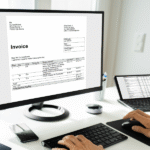With the new rule from LHDN that all Malaysian firms must send e-bills, many small businesses are hurrying to meet this need. Yet, they often make mistakes that no one sees—these can slow down work, make tax reports wrong, and break rules.
If you use QuickBooks in Malaysia, knowing these traps and how to dodge them can save you not just time, but also keep your firm in line with the MyInvois rules from Lembaga Hasil Dalam Negeri (LHDN).
1. Relying on Manual MyInvois Submissions
The issue: Many small firms still log into the LHDN MyInvois site by hand to make and send off bills. This way takes a lot of time and can lead to mistakes, more so for firms with many deals.
How to fix it: Using your book-keeping system to send e-bills is a better way. For those who use QuickBooks, tools like the LHDN MyInvois Connector from Advintek let you send bills straight to MyInvois, so you don’t have to switch between systems.
2. Sending Bills in the Wrong Way
The issue: LHDN says that all e-bills must be in a tight XML form to follow the rules. Sending bills in the wrong form can cause them to be turned down or lead to fines.
How to fix it: QuickBooks by itself doesn’t make bills in the LHDN-okayed XML setup. Using a proper connector makes sure your bills change into the right form before you send them.
3. Missing the 72-Hour Invoice Cancellation Window
The issue:
One of the most overlooked compliance requirements is the 72-hour deadline to cancel an issued invoice. Without alerts or automated tracking, many SMEs miss this window.
How to avoid it:
Ensure your system supports real-time invoice tracking and provides the option to cancel directly within 72 hours. Integration tools like Advintek’s connector offer this functionality natively in QuickBooks.
4. Lack of Real-Time Data Sync Between Systems
The issue:
When your accounting software and invoicing system aren’t synced, data discrepancies can arise—leading to duplicate entries, reporting errors, and compliance issues.
How to avoid it:
A link that updates at the same time keeps data the same in QuickBooks and the Invoice Factory. If you make bills, change client info, or scrap a note, all stays set and ready for checks.
5. Not Preparing for LHDN’s 7-Year Audit Archiving Requirement
The issue:
Businesses are required to store all issued e-Invoices and related metadata for 7 years in a secure, retrievable format. Manual backups or storing on personal drives is risky and non-compliant.
How to avoid it:
Choose a system that automatically stores all e-Invoices in LHDN-compliant storage for long-term retrieval. Advintek’s integration supports audit-ready archiving that aligns with Malaysian tax laws.
Built for Malaysian SMEs Using QuickBooks
No matter if you work in retail, service, law, or online sales, using an auto e-Invoice set-up from your accounting system is a must now.
With QuickBooks + an approved LHDN plug-in, firms can:
- Send, stop, and keep an eye on invoices from QuickBooks
- Make sure all invoices use the right XML type
- Keep up with audit and report needs Cut down on time and faults from doing things by hand
Advintek, the first to start a full QuickBooks + LHDN link, gives a smooth fix—powered by auto, rules-following, and live data work. More than that, it helps small and mid-sized firms adjust without messing up how they work now.
Final Thoughts
Steer clear of these five big errors to keep your business on track, smooth, and set for checks under Malaysia’s fresh e-Invoicing rules.
If you are now on QuickBooks, the move you need is easy: link it with a safe, LHDN-fit tool that weaves following rules into your day-to-day tasks—not making it harder.
💡 Need Help Getting Started?
👉 Book a Free Demo to see how easy e-Invoicing can be with the right system.
No extra steps. No manual uploads. No compliance stress.









